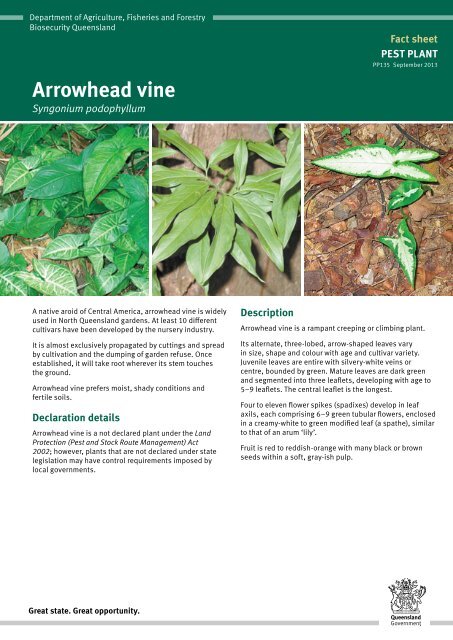Arrowhead vine - Department of Primary Industries
Arrowhead vine - Department of Primary Industries
Arrowhead vine - Department of Primary Industries
You also want an ePaper? Increase the reach of your titles
YUMPU automatically turns print PDFs into web optimized ePapers that Google loves.
<strong>Department</strong> <strong>of</strong> Agriculture, Fisheries and Forestry<br />
Biosecurity Queensland<br />
<strong>Arrowhead</strong> <strong>vine</strong><br />
Syngonium podophyllum<br />
Fact sheet<br />
PEST PLANT<br />
PP135 September 2013<br />
A native aroid <strong>of</strong> Central America, arrowhead <strong>vine</strong> is widely<br />
used in North Queensland gardens. At least 10 different<br />
cultivars have been developed by the nursery industry.<br />
It is almost exclusively propagated by cuttings and spread<br />
by cultivation and the dumping <strong>of</strong> garden refuse. Once<br />
established, it will take root wherever its stem touches<br />
the ground.<br />
<strong>Arrowhead</strong> <strong>vine</strong> prefers moist, shady conditions and<br />
fertile soils.<br />
Declaration details<br />
<strong>Arrowhead</strong> <strong>vine</strong> is a not declared plant under the Land<br />
Protection (Pest and Stock Route Management) Act<br />
2002; however, plants that are not declared under state<br />
legislation may have control requirements imposed by<br />
local governments.<br />
Description<br />
<strong>Arrowhead</strong> <strong>vine</strong> is a rampant creeping or climbing plant.<br />
Its alternate, three-lobed, arrow-shaped leaves vary<br />
in size, shape and colour with age and cultivar variety.<br />
Juvenile leaves are entire with silvery-white veins or<br />
centre, bounded by green. Mature leaves are dark green<br />
and segmented into three leaflets, developing with age to<br />
5–9 leaflets. The central leaflet is the longest.<br />
Four to eleven flower spikes (spadixes) develop in leaf<br />
axils, each comprising 6–9 green tubular flowers, enclosed<br />
in a creamy-white to green modified leaf (a spathe), similar<br />
to that <strong>of</strong> an arum ‘lily’.<br />
Fruit is red to reddish-orange with many black or brown<br />
seeds within a s<strong>of</strong>t, gray-ish pulp.<br />
Great state. Great opportunity.
Control<br />
Manual control<br />
Hand pull isolated plants and small infestations, making<br />
sure that all roots and stem fragments are removed. Plant<br />
pieces should either be bagged and taken to the dump or<br />
hung up <strong>of</strong>f the ground to prevent reshooting.<br />
Herbicide control<br />
There is no chemical currently registered for control <strong>of</strong><br />
arrowhead <strong>vine</strong> in Queensland; however, <strong>of</strong>f-label use<br />
permit (Permit No. PER11463) allows the use <strong>of</strong> various<br />
herbicides for the control <strong>of</strong> environmental weeds in<br />
non-agricultural areas, bushland, forests, wetlands, and<br />
coastal and adjacent areas.<br />
See Table 1 for treatment options allowed by the permit.<br />
It is important to note that specific research on the use<br />
<strong>of</strong> herbicides to control arrowhead <strong>vine</strong> has not been<br />
undertaken to date. Therefore, the treatment options<br />
outlined in Table 1 are suggestions only, based on<br />
registered controls for similar weeds in non-agricultural<br />
areas and the specifications <strong>of</strong> PER11463. As such, their<br />
effectiveness cannot be guaranteed.<br />
Prior to using the chemicals listed under PER11463<br />
you must read or have read to you and understand<br />
the conditions <strong>of</strong> the permit. To obtain a copy <strong>of</strong> this<br />
permit contact your local council weed inspector or visit<br />
www.apvma.gov.au<br />
It is a requirement <strong>of</strong> the permit that all persons using<br />
products covered by this <strong>of</strong>f-label permit comply with the<br />
details and conditions listed in the permit. Permit number<br />
PER11463 expires on 30 June 2014. While the permit may<br />
be extended beyond this date, there is no guarantee that<br />
it will, so contact your local council weed inspector for the<br />
latest information after the expiry date.<br />
Follow up<br />
Monitor treated areas regularly for any new seedlings<br />
or regrowth.<br />
Further information<br />
Further information is available from your local<br />
government <strong>of</strong>fice, or by contacting Biosecurity<br />
Queensland (call 13 25 23 or visit our website at<br />
www.deedi.qld.gov.au).<br />
Table 1. Herbicides approved for the control <strong>of</strong> arrowhead <strong>vine</strong><br />
Method Herbicide Rate Registration status Comments<br />
Spot spray Glyphosate (360 g/L) 1 L per 100 L water APVMA permit PER11463<br />
Spot spray 2,4-D (500 g/L) 4 ml per 1 L water<br />
Spot spray Fluroxypyr (200 g/L) 500 ml to 1 L per 100 L water<br />
Spot spray<br />
Metsulfuron-methyl<br />
(600 g/kg)<br />
10 g per 100 L water plus<br />
wetting agent<br />
Permit expires 30/06/2014<br />
Read permit carefully prior<br />
to use<br />
Read the label carefully before use. Always use the herbicide in accordance with the directions on the label.<br />
This fact sheet is developed with funding support from the Land Protection Fund.<br />
Fact sheets are available from <strong>Department</strong> <strong>of</strong> Agriculture, Fisheries and Forestry (DAFF) service centres and our Customer Service Centre (telephone 13 25 23). Check<br />
our website at www.biosecurity.qld.gov.au to ensure you have the latest version <strong>of</strong> this fact sheet. The control methods referred to in this fact sheet should be used in<br />
accordance with the restrictions (federal and state legislation, and local government laws) directly or indirectly related to each control method. These restrictions may<br />
prevent the use <strong>of</strong> one or more <strong>of</strong> the methods referred to, depending on individual circumstances. While every care is taken to ensure the accuracy <strong>of</strong> this information,<br />
DAFF does not invite reliance upon it, nor accept responsibility for any loss or damage caused by actions based on it.<br />
© The State <strong>of</strong> Queensland, <strong>Department</strong> <strong>of</strong> Agriculture, Fisheries and Forestry, 2013.

















